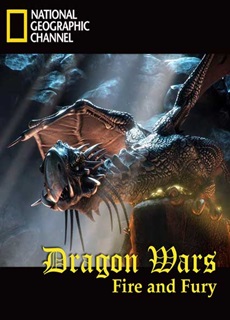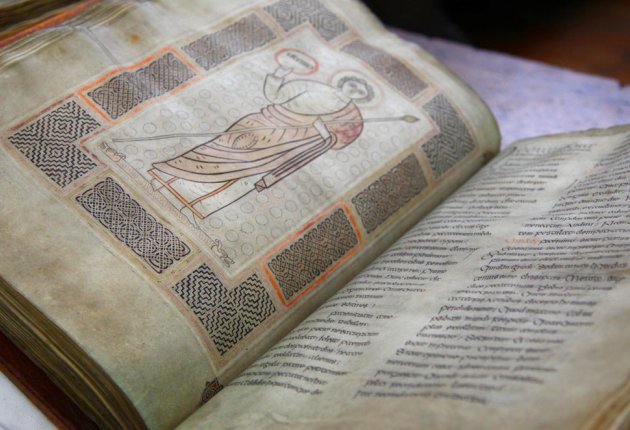Produced for National Geographic, Dragon Wars – Fire and Fury is an infotainment documentary about mythological dragons and their possible links to actual history, including the Vikings.
Dragon Wars – Fire and Fury is an infotainment documentary about mythological dragons and their possible links to actual history, including the Vikings.
The Vikings did not only believe in Thor and Odin and forest trolls, they also believed in dragons, the fire-breating giant lizzard that was “known” to most of the world even in ancient times. Dragon Wars – Fire and Fury focuses on dragon myths in Medieval Europe, with more than half the movie looking at the Vikings’ relations to dragons.
The 47 minute documentary is split into four chapters, with the first one talking about the monks of Lindisfarne in Northern England, who in the year 793 were attacked by heathen invaders; Vikings. The documentary argues that the monks did believe in dragons, as did their fellow Anglosaxons, who recorded this passage about the Viking attack in 793:
This year came dreadful fore-warnings over the land of the Northumbrians, terrifying the people most woefully: these were immense sheets of light rushing through the air, and whirlwinds, and fiery, dragons flying across the firmament. These tremendous tokens were soon followed by a great famine: and not long after, on the sixth day before the ides of January in the same year, the harrowing inroads of heathen men made lamentable havoc in the church of God in Holy-island, by rapine and slaughter.
The real-life dragons the monks faced were perhaps Vikings, with their strange clothes, big sails and dragon-decorated longboats?
The documentary then claims that the legend of Beowulf, as described in the famous poem, may have roots in reality, as opposed to being just a work of fiction and imagination. The dragon in the poem is supposed to symbolize the protection of barrows (burial mounds), and when looters steal from a tomb protected by the dragon, it seeks revenge, something Beowulf must stop. Grave plundering was taboo, hence warnings in the form of dragon legends. Reality may have kicked in, says the documentary, when archeologists found a ship and weapons at Sutton Hoo; remnants of a warrior king from the same era that Beowulf supposedly lived. The find included a helmet with a golden dragon as decoration.
The second chapter shows us how the Vikings themselves were haunted by dragons. Not only did they believe that a giant serpent surrounded the entire world, but they also used dragons in a more solid way, as symbolic decorations extended from the bow or stern. The big Viking dragon in the legends even had a name; Fafnir, a former human turned dragon who was killed by Sigurd, a famous character in Viking mythology. Not only is the myth of Sigurd explained in this documentary; his work is actually depicted in runestones, and was also the subject of a Norwegian Viking film for children, The littlest Viking.
The third chapter introduces us to a Norman (a French Viking) knight, sir John Conyers, who supposedly slayed a dragon or “worm” that terrorised the district. Conyers was a historical person, and his sword us today used in Christian ceremonies. He never did kill a dragon of course, but could have used dragon legends to reinforce his political position. He is also seen as a symbol for Christianity taking a definitive stand against the Vikings, whose victims were no longer monks with books, but monks with swords!
The final 20 minutes of the documentary – which has nice CG animation, considering it is not a 100 million dollar feature – deals with non-Viking Medieval myths, with the same type of documentation; old manuscripts, archeological objects and folk legends.
Dragon Wars – Fire and Fury is not the most scientifically accurate documentary you will ever see. I can’t put my finger on any specific errors in it (a historian might), but the overall feeling is that it combines “evidence” in creative ways and stretches imagination more than serious documentaries should. By no means does it suggest that dragons ever existed, but it does suggest that some of the finds and old texts prove that both monks and Vikings literally referred to dragons in their drawings, carvings and transcripts. That is historical extrapolation without the possibility of fiction or allegory being part of the picture. There’s no room for alternative theories, such as the Sutton Hoo helmet having a bird depicted, rather than a dragon. The bird theory is an option defended by the British Museum, but that would ruin the premise of this film, so it is not mentioned.
As it stands, Dragon Wars is more infotainment than history, and could perhaps establish some people’s interest in history and entice them to look deeper into the subjects covered. But again, for that angle to be taken seriously, the documentary could have had a less stronger belief in the mythology it presents.
Rated 6 of 10.
USA, 2012.

